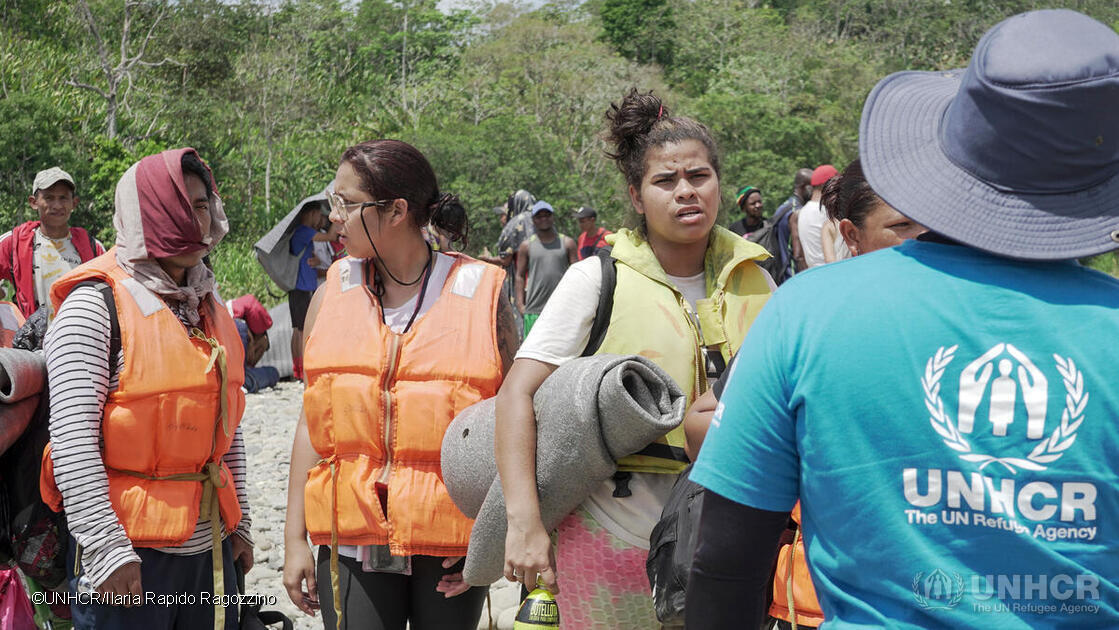By Andrea Pellandra and Alejandra Moreno Ramirez

Expanding the Microdata Library
In 2024, UNHCR reinforced its commitment to responsibly sharing data and supporting evidence-based decision-making to enhance the lives of forcibly displaced and stateless populations. As part of this effort, the Microdata Library (MDL) expanded with 152 new datasets, bringing the total to 884—746 from UNHCR and 138 from external sources (see Figure 1 for a regional breakdown). A notable addition in 2024 was the publication of the South Sudan Forced Displacement Survey (FDS), part of the UNHCR global socio-economic household survey programme designed to streamline and standardize multi-topic and timely data collection on displaced populations and host communities, providing critical comparative insights into their needs, vulnerabilities, and coping mechanisms.
The Microdata Library serves as the public portal for accessing anonymized microdata collected by UNHCR and its partners, fostering collaboration between humanitarian and development actors. This expansion ensures that more comprehensive and updated data is now available for research, analysis, and policymaking.

Enhancing Data Access and Privacy with Differential Privacy
UNHCR remains at the forefront of innovation in data curation, continuously refining methodologies to balance data accessibility with robust privacy protections. Since 2020, statistical disclosure control methods have been the standard for anonymizing datasets in the Microdata Library. However, particularly for statistical census data, these techniques have limitations, as they require sampling approaches that can greatly reduce the utility of published datasets. These limitations had so far prevented UNHCR from publicly sharing its registration data, a comprehensive dataset containing critical information about forcibly displaced people registered by the organization.
To overcome these challenges, in 2024 UNHCR worked with a researcher at the University of California-Berkeley to test the application of differential privacy, a state-of-the-art approach that enables the secure release of full-size synthetic datasets. These datasets are generated by adding ‘noise’ to the data, ensuring the confidentiality of the records is maintained, while also ensuring that they maintain many of the same properties as the original dataset and allow derivation of the same results and insights. The work was challenging due to the complex relational structure across multiple tables and the presence of mixed data in UNHCR registration records. However, using the open-source OpenDP library, it was possible to generate full-size synthetic data with strong privacy properties, as well as richer and more accurate data compared to previously used statistical disclosure methods.
This year will mark a milestone as differentially private synthetic registration datasets will be made available for the first time on the Microdata Library. These comprehensive datasets will provide new opportunities for researchers, NGOs, and policymakers to gain deeper insights into refugee demographics, protection needs, skills, and assistance received—ultimately supporting more effective responses to forced displacement.
Growing User Engagement and Impact
As the Microdata Library continues to expand, its growing user base reflects its critical role in advancing research, policy, and humanitarian initiatives. With an increasing number of users accessing and utilizing its datasets, the Microdata Library is becoming an indispensable resource for evidence-based decision-making.
In 2024, close to 24,000 users accessed the platform, with over 1,700 data download requests—a majority originating from academic institutions (refer to Figure 2 for a detailed breakdown by user type). Researchers, humanitarian organizations, and policymakers rely on the Microdata Library’s extensive datasets to analyze trends, inform strategic planning, and support data-driven decision-making.
One recent example of its academic contribution is the study “The short-term effects of visa restrictions on migrants’ legal status and well-being: A difference-in-differences approach on Venezuelan displacement” by Omar Hammoud Gallego, published in World Development. This research utilized data from 85,000 migrants and refugees surveyed by UNHCR, shedding light on the consequences of visa restrictions on migration flows across South America.

Looking Ahead to 2025
The progress achieved in 2024 reinforces UNHCR’s vision for the Microdata Library as a key resource for humanitarian and development actors. Looking ahead, we aim to further enhance interoperability with other global data platforms, making it easier to combine and compare datasets across different sources.
Since September 2024, microdata from four of the Microdata Library’s thematic collections (Vulnerability Assessments, Socioeconomic Assessments, IDP Profiling, Needs Assessments) have been sourced by the International Monetary Fund (IMF) for its internal Forced Displacement Portal, which leverages over 90 external open-source indicators relevant to the IMF country teams’ engagements with countries impacted by forced displacement. The portal showcases both data and analytics, benefiting from regular updates directly from partners’ open sources. The IMF plans to launch the portal externally in mid-2025, aiming to increase data access for academics and researchers working on forced displacement and its macroeconomic impact.
Additionally, the integration of synthetic datasets and privacy-enhancing technologies will enable even broader data access while maintaining the highest standards of confidentiality.
By continuing to innovate in both data publication and privacy safeguards, UNHCR is ensuring that humanitarian microdata remains a powerful tool for improving the lives of forcibly displaced and stateless populations.
We look forward to another year of impactful data sharing and collaboration!
